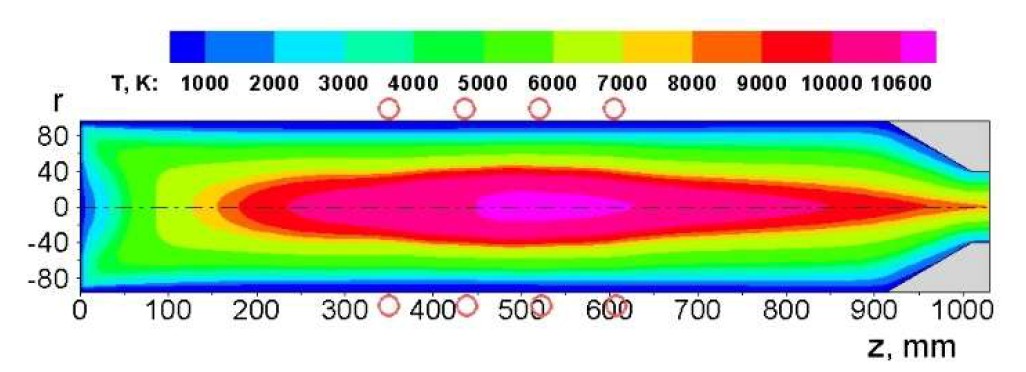
Numerical study of subsonic air plasma flows in a sectioned discharge channel of the VGU-3 HF-plasmatron was performed based on the Navier-Stokes equations coupled with the two-dimensional equations describing the vortex electromagnetic field, for pressures of 100 and 50 hPa and anode power supply of the HF generator of 100-300 kW. The plasma flow parameters at the channel exit section were determined for these regimes - velocity components, enthalpy, temperature, molar composition, Mach and Reynolds numbers. Graphs of gas parameters radial profiles at the channel exit section, parameters distributions along the channel symmetry axis from the inlet section to the channel outlet, stream function isolines and isotherms in the channel are presented. It is shown that the use of a lengthened sectioned discharge channel instead of a simple channel for the VGU-3 plasmatron leads to the increase in axial velocity by 4 times and to the decrease in flow enthalpy by 10-20% on the axis of symmetry at the channel exit section for the considered plasmatron regimes, that allows to significantly expand the range of modeling of natural aerodynamic heating in experiments at VGU-3.
HF-plasmatron, discharge channel, dissociated air, numerical simulation, inductively coupled plasma

Проведено численное исследование дозвуковых течений плазмы воздуха в секционированном разрядном канале плазмотрона ВГУ-3 на основе уравнений Навье Стокса и двумерных уравнений, описывающих вихревое электромагнитное поле, для давлений 100 и 50 гПа и мощностей ВЧ-генератора по анодному питанию в диапазоне 100 - 300 кВт. Для этих режимов определены параметры потока плазмы на выходе из канала - компоненты скорости, энтальпия, температура, молярный состав, числа Маха и Рейнольдса. Представлены графики радиальных профилей параметров газа на выходе из канала, распределения параметров вдоль оси симметрии внутри канала от входного сечения до выхода из канала, изолинии функции тока и изотермы в канале. Показано, что использование секционированного разрядного канала вместо простого канала для плазмотрона ВГУ-3 приводит к увеличению продольной компоненты скорости в 4 раза и к уменьшению энтальпии потока на 10-20% на оси симметрии на срезе канала для рассмотренных режимов, что позволяет существенно расширить диапазон моделирования натурного аэродинамического нагрева в экспериментах на ВГУ-3.
ВЧ-плазмотрон, разрядный канал, диссоциированный воздух, численное моделирование, индукционная плазма